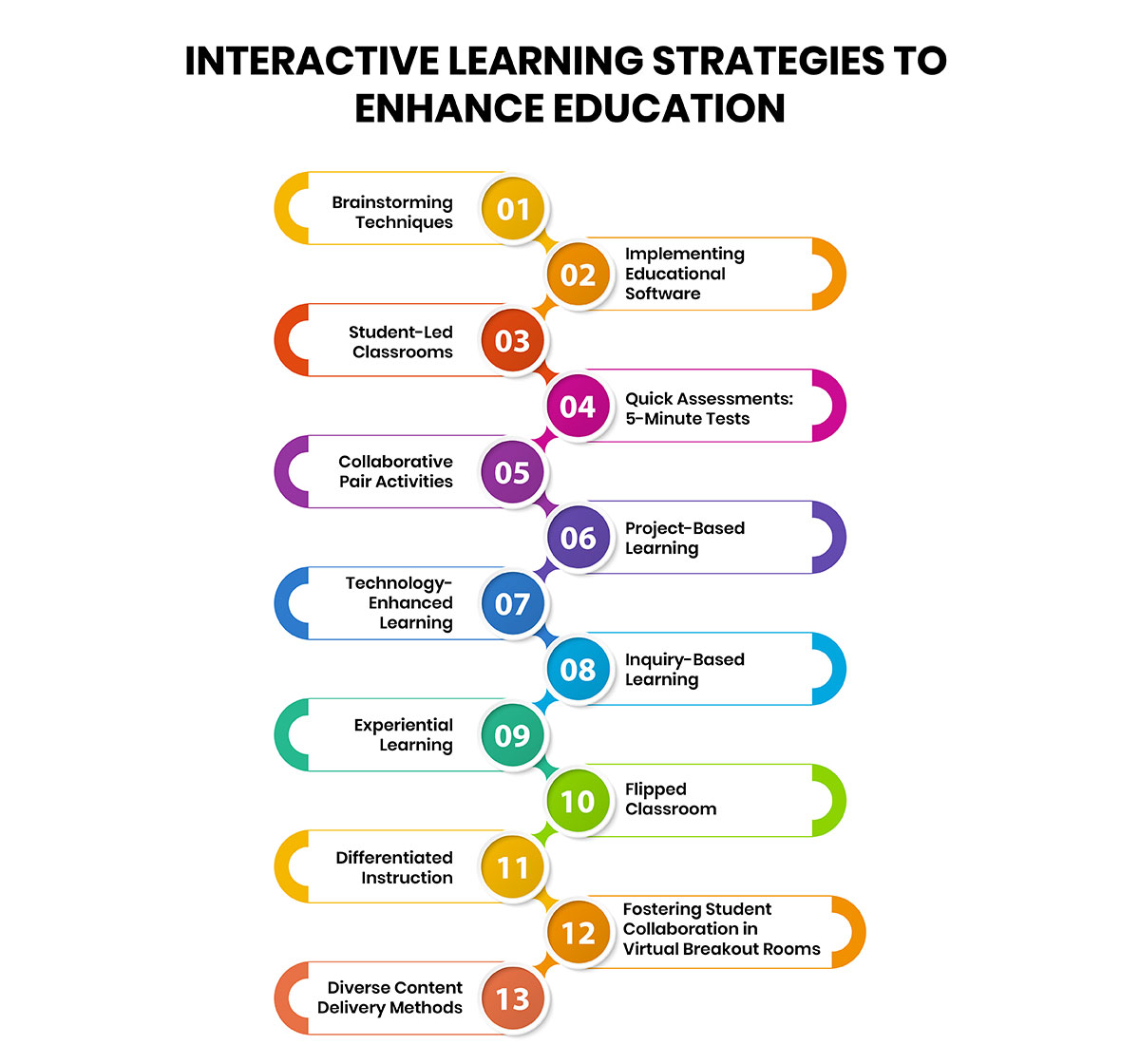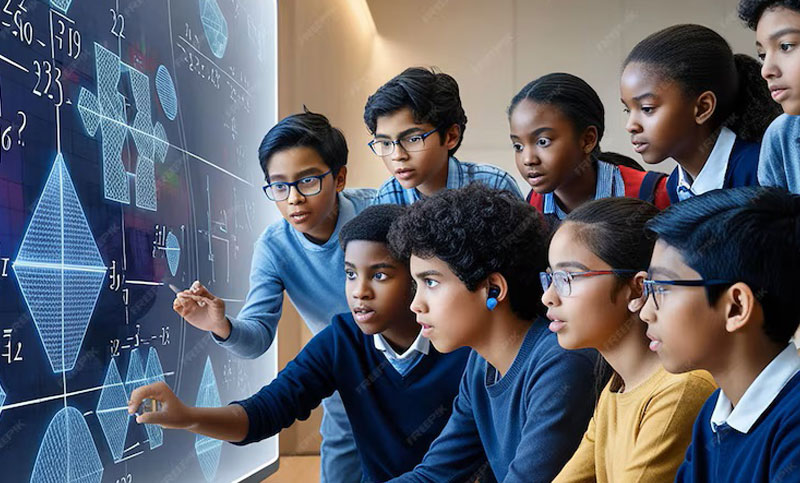Reforming Academic Success Through Interactive Learning Techniques
October 07, 2024A student-centered classroom shifts the focus from the teacher to the learner, emphasizing the student’s active role in the learning process. In such an environment, the teacher facilitates learning by offering meaningful and relevant activities tailored to students' needs, interests, and learning styles. This approach cultivates critical thinking, problem-solving, and decision-making skills while encouraging students to take ownership of their education. By promoting interactive learning, these classrooms create a positive atmosphere where students feel respected, valued, and engaged, which in turn enhances their motivation to learn.
To meet the needs of today’s learners, schools are increasingly adopting interactive learning strategies, moving away from traditional methods that can stifle student performance. Educational institutes now rely on advanced tech tools and software to create more dynamic, engaging environments. While the cost of such educational technology, like school management software, can be high, it’s crucial to recognize that meaningful interactive learning requires more than just tools—it demands intentional curriculum design. Particularly in online settings, interactive learning strategies are essential to keep students engaged and active in their learning, especially in K-12 programs where creating an engaging and interactive syllabus is key to student success.
The Necessity for Interactive, Student-focused Classrooms
In today’s evolving educational setting, the need for interactive, student-oriented classrooms has never been more essential. Unlike traditional teacher-led approaches, where students passively absorb information, student-centered classrooms place learners at the heart of the process. Here, teachers act as facilitators rather than lecturers, guiding students to explore, question, and engage with the material actively. This shift encourages students to collaborate, participate in discussions, and even pursue topics of personal interest, making learning more meaningful and relevant to their lives. This approach not only enhances critical thinking and problem-solving skills but also prepares students to apply knowledge in real-world situations.
One of the key advantages of interactive, student-focused classrooms is the ability to cater to diverse learning needs. Every student learns differently, and personalized instruction allows teachers to craft lessons to meet individual requirements. Through these teaching strategies, educators can use activities and tools that engage different learning styles, resulting in higher levels of student engagement and improved academic performance. Students feel more empowered when they are in control of their learning, leading to greater confidence and motivation. When students are given opportunities to take ownership of their education, it fosters deeper understanding, retention, and, ultimately, a more successful learning experience.
By moving away from passive, lecture-based models, interactive classrooms create vibrant learning environments where engagement and participation are prioritized. This not only improves academic outcomes but also nurtures independence, curiosity, and a lifelong passion for learning. Such classrooms are crucial for developing future-ready individuals capable of adapting to the challenges of an ever-changing world.
How Interactive Lessons Boost Student Engagement
Interactive lessons play a crucial role in enhancing student engagement by shifting the focus from passive listening to active participation. In an interactive classroom, students are encouraged to take part in hands-on activities, discussions, and group work that not only promote learning but also develops collaboration and excitement.
When students are actively involved in the learning process, they become more invested in their education. Whether through problem-solving tasks, real-time feedback, or dynamic group projects, interactive lessons create a fast-paced, stimulating environment where students are constantly engaged with the material. This type of learning also allows them to work closely with their peers, facilitating both academic and social growth.
By providing an engaging learning atmosphere, interactive lessons help students retain information better and build a deeper understanding of concepts. Moreover, the sense of accomplishment from actively participating in these lessons can increase motivation, making students more likely to enjoy their learning journey and strive for academic success.
Powerful Interactive Learning Strategies to Enhance Education
Conventional teaching often leaves students disengaged, but by adopting interactive strategies, educators can create dynamic learning environments where students actively participate and excel. Below are some key strategies that enhance learning through interaction, creativity, and collaboration.

-
1.Brainstorming Techniques
Interactive brainstorming methods allow students to collaborate, explore ideas, and develop creative solutions. This group-based activity promotes analytical thinking and problem-solving. Strategies like team-idea mapping, group passing, reverse thinking, and both structured and unstructured brainstorming sessions help students develop mental agility and encourage a collaborative classroom culture. -
2.Implementing Educational Software
The integration of technology in education has revolutionized how learning is delivered. Digital tools enable educators to create visual learning experiences, monitor student progress, and offer personalized instruction. Educational software platforms streamline classroom management and elevate the learning experience by creating immersive digital classrooms. -
3.Student-Led Classrooms
Switching roles between students and teachers for a day is an effective way to encourage leadership, empathy, and accountability. In student-led classrooms, students take on the responsibility of teaching younger peers, which enhances their communication skills and deepens their understanding of the subject. This practice builds student engagement and provides insight into the complexities of teaching. -
4.Quick Assessments: 5-Minute Tests
Short, frequent assessments are a powerful tool to ensure that students are absorbing and understanding key concepts. Conducting a quick 5-minute test at the end of each lesson provides immediate feedback, allowing educators to identify areas where students may need further clarification or review. -
5.Collaborative Pair Activities
Pairing students for activities such as presentations or group discussions promotes cooperative learning. This not only helps students learn from each other but also introduces a healthy sense of competition. Engaging in peer-to-peer learning supports teamwork, analytical reasoning, and proficient communication. -
6.Project-Based Learning
Project-based learning encourages students to explore real-world problems in a hands-on, inquiry-driven format. By working on projects, students develop groupwork, research, and presentation skills. This strategy makes learning more relevant and engaging, motivating students to apply their knowledge in practical scenarios. -
7.Technology-Enhanced Learning
Incorporating technology into lessons, such as using interactive whiteboards, simulations, and educational apps, brings an added layer of interactivity to the classroom. Tools like virtual labs and gamified learning environments allow students to engage with content in innovative ways, making complex subjects easier to understand. -
8.Inquiry-Based Learning
Encouraging students to ask questions and seek answers helps cultivate curiosity and critical thinking. Inquiry-based learning shifts the focus from rote memorization to exploration and discovery, enabling students to take an active role in their education. -
9.Experiential Learning
Providing real-world experiences, such as field trips, simulations, or experiments, allows students to connect theoretical knowledge with practical application. Experiential learning promotes deeper engagement and enhances students' understanding of how classroom lessons relate to real-life situations. -
10.Flipped Classroom
In the flipped classroom model, students study lesson materials independently at home through videos or readings and use class time for interactive, experiential learning. This approach encourages active participation in discussions and collaborative projects, making class time more productive and engaging. -
11.Differentiated Instruction
Tailoring instruction to meet individual student needs ensures that every learner can access the curriculum in a way that suits them. By adjusting content, teaching methods, and assessments based on student readiness and interests, educators can provide a more inclusive learning environment. -
12.Fostering Student Collaboration in Virtual Breakout Rooms
In remote learning settings, creating opportunities for students to collaborate in virtual breakout rooms helps maintain engagement. Various online platforms like Zoom allow teachers to organize group discussions and collaborative projects, mirroring in-person learning environments. -
13.Diverse Content Delivery Methods
To keep online learners engaged, it’s essential to use a variety of content formats, including videos, audio, and interactive presentations. Regular feedback and student surveys can help ensure that the course materials are both accessible and effective, allowing for continuous improvement in the delivery of content.
Conclusion
Embracing interactive learning techniques is crucial for fostering an educational environment that promotes student engagement and academic success. By prioritizing active participation and collaboration, educators can create dynamic classrooms where students feel empowered to take charge of their learning journey. The strategies outlined not only enhance understanding and retention but also nurture essential skills such as critical thinking and problem-solving. As education continues to evolve, the integration of innovative practices will be key in meeting the diverse needs of learners. Ultimately, by committing to interactive approaches, we can cultivate a generation of motivated, independent thinkers prepared to navigate the complexities of the modern world.




